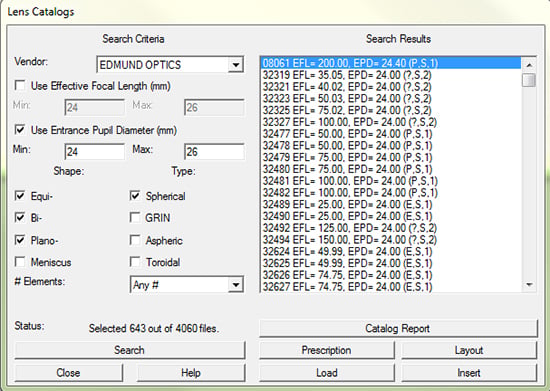5 Tips for Designing with Off-the-Shelf Optics
Authors: Jeremy Govier
Using off-the-shelf optics in your next design project comes with many advantages. If budget or time restrictions eliminate the possibility of utilizing custom optics in your application, stock optics are readily available and easily implemented to fit your design requirements. Here are some quick tips to help make designing with off-the-shelf optics easy.
1. Simplify
Start on paper with a paraxial design and break it into subsystems of finite and infinite conjugate optical groups. Determine the focal lengths you want for each group on paper before trying to optimize in a code like Zemax, Code V, or another ray tracing software of your choice. Once you have the focal lengths required, you can start using paraxial equations to help choose the off-the-shelf lenses that provide the required focal lengths. Your preferred ray tracing code should have a selection of off-the-shelf lenses built into it (Figure 1) that you can use to model the selected lenses and optimize your spacing. If not, the lenses can typically be input into the software with the information provided by the supplier. All Edmund Optics TECHSPEC® components are available in most design codes and Zemax files are available on our website.

Figure 1: Lens Catalog from Zemax
2. Go Monochromatic
If at all possible, use a monochromatic source such as an LED or Laser or use an optical filter to make your system monochromatic. Using a monochromatic or narrow band light will greatly reduce the complexity of the design. As a rough guideline, reducing the source waveband to less than 50nm will generally make using singlets possible in your design. Chromatic aberrations cause difficulty when composing a design, so your options will be simplified if a broadband light source is not required.
3. Utilize Off-the-Shelf Subsystems for Additional Aberration Correction
By using off-the-shelf components such as achromatic doublets, microscope objectives, machine vision lenses, multi-element relays, or other subsystems, you can often achieve your application's exact correction requirements for factors such as color, field angles, and large apertures. In many cases, these subsystems can even be modeled in your code if the prescriptions are provided by the supplier (Figure 2). Even if the prescription is not available, a paraxial surface can be used to approximate the subsystem.

Figure 2: Prescription of Edmund Optics Micro Video Lens (#58-204)
4. Consider Mounting Options
Whether you are prototyping or trying to save the time and expense associated with purchasing custom housings, consider off-the-shelf mounting options. Optical Cage systems allow you to easily assemble your optical components, and provide plenty of freedom for making spacing adjustments. Most off-the-shelf cage systems allow for mounting common optical component sizes, as well as ways for mounting microscope objectives, C-mount camera lenses, and other subcomponents.
5. Use Components Where They Work
Off-the-shelf lenses such as Plano-Convex (PCX), Plano-Concave (PCV), Double-Convex (DCX), Double-Concave (DCV), and Achromats are optimized for small fields and small apertures. These components work best when integrated into systems that do not have very steep ray angles. For example, when designing a high magnification relay, use a complex multi-element group for the high numerical aperture side of the relay and an achromat for the low numerical aperture side. For instance, a 15X system (Figure 3) consisting of a 20X infinite conjugate objective on the object side and a 150mm focal lenth achromatic lens on the image side will provide a very well-corrected system.

Figure 3: Using Off-the-Shelf Components, you can Quickly Assemble a 15X Microscope
Looking to learn about optics and optical design?
Learn the basics of optics needed to begin designing optical systems in this educational, online Fundamentals of Optics course co-created by Edmund Optics and Zemax. It does not require any previous knowledge in the field of optics.













or view regional numbers
QUOTE TOOL
enter stock numbers to begin
Copyright 2024, Edmund Optics Singapore Pte. Ltd, 18 Woodlands Loop #04-00, Singapore 738100
California Consumer Privacy Acts (CCPA): Do Not Sell or Share My Personal Information
California Transparency in Supply Chains Act